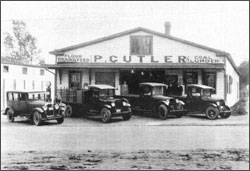The Town of Colchester, Connecticut was founded in 1698 at a point just north of the present Town Green at Jeremiah’s Farm on land purchased by Nathaniel Foote from the Sachem of the Mohegan Indians. Nathaniel Foote’s grandfather had emigrated from Colchester, England, early in the 17th century and Colchester in America was the vision of a group of early English settlers who sought to lay out a new plantation in a large tract of virgin wilderness.
Colchester’s early history , like many towns in New England, centered around the church parish. In 1703, the General Court of the Colony of Connecticut ruled that the settlement could organized a church body here known as Colchester. Several grist mills and saw mills to provide grain and lumber were built within a few years. In 1706, the first steet was laid out and called Town Street. This street was nearly 200 feet wide and is now the southern end of Old Hebron Road. By 1714, there were nearly 50 new families in town.
, like many towns in New England, centered around the church parish. In 1703, the General Court of the Colony of Connecticut ruled that the settlement could organized a church body here known as Colchester. Several grist mills and saw mills to provide grain and lumber were built within a few years. In 1706, the first steet was laid out and called Town Street. This street was nearly 200 feet wide and is now the southern end of Old Hebron Road. By 1714, there were nearly 50 new families in town.
By 1756 Colchester was one of the most thriving rural towns in the Colony. Its population was recorded as 2,300 inhabitants and by 1782 grew to 3,300.
Settlers were mostly self-sufficient. One of the first textile mills in America began operation in 1780 in Westchester. Other early industries were iron works, clothier shops, potash works and brick kilns. The 19th century industrial expansion in America was evident in Colchester. In 1819, there were three tanneries and a woolen mill, a hatter in 1828, a wheel and carriage factory in 1858, a paper mill in 1869, a creamery in 1886 and a canning company in 1893.
During this industrial heyday, the Hayward Rubber Company was established in 1847. Nathaniel Hayward along with Charles Goodyear had discovered the process of vulcanized rubber. It is said the Hayward was the true inventor and that Goodyear provided the cash to fund his experiments. Hayward founded his new company in Colchester and from here rubber products, boots, and shoes were shipped all over the country. The company thrived until 1893 when it was closed and later the building burned to the ground.
With industrial growth came the demand for labor and a population growth. The town prospered. New Homes and sidewalks were built, a park was laid out and the streets were lighted with lamps.
Transportation during this period included the railroad. In 1875 the link between Willimantic and Middletown on the Boston to New York line was completed. The section ran through North Westchester and over the Lyman Viaduct to the west. In 1876, the town appropriated $25,000 to lay track between Colchester and Amston. Both freight and passengers were carried over this track for nearly 80 years.
